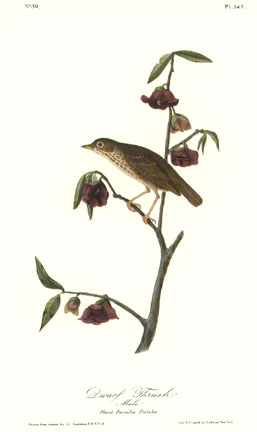

147 DWARF THRUSH
| The history of our smaller Thrushes has been involved in obscurity
by the attempts which have been made to restore to some of those
described by WILSON the names supposed to have been bestowed on them by
European writers, and by changing the names given by WILSON to such as
could not satisfactorily be referred to previous writers. The
difficulties that present themselves when we attempt to recognise
species ill figured and slightly described, are very great, and I have
often thought that too little credit had been given to WILSON with
respect to the smaller Thrushes which he has described, and which no
European writer, who has not studied their habits and procured the birds
in our woods, can correctly characterize, unless he may have a great
number of specimens, ticketed when obtained, and shewing the differences
as to size and markings that occur in old and young individuals, males
and females, and which are the more difficult to judge of on account of
the general mutual resemblance of birds of this genus. Experience has
proved to me that the size, and to some extent, the colour of the spots
on the breast of our small Thrushes differ in winter and summer, as the
tips of the feathers become more or less worn. Nature, however, has
provided each species with characters, which may with care and patience
be understood.
After a careful examination and comparison, I was induced to consider the present as a new species, to which, on account of its small size, I gave the name of "Dwarf Thrush, T. nanus." It is nearly allied to the Hermit Thrush, but is smaller, and has the second and sixth quills nearly equal, whereas in T. solitarius the second quill is considerably shorter than the sixth. It must be confessed that it differs very little from that species, excepting as to size, and especially that of the bill. It is extremely rare in our Atlantic districts, where, however, I have procured a few individuals. Indeed, the first intimation which I received respecting it was from my friend Dr. CHARLES PICKERING Of Philadelphia, who, having procured one, had kept its wings and head, the smallness of which struck me at once. I was then far from imagining that its native haunts were the valleys of the Columbia river, from which, however, I have since received it through the kindness of my friend Mr. TOWNSEND, who has also sent me its measurements, "length 6 inches, alar extent 9," or one inch less in length, and one and a half less in breadth than the Hermit Thrush, with which it has probably been hitherto confounded. I am of opinion that no distinctive character can be obtained from the colouring of the inner webs of the quills as seen from beneath, those parts being more or less yellowish or buffy in all the species. This is the smallest of our Thrushes; and was represented in Plate CCCCXIX. of my large work, under the name of "Little Tawny Thrush, Turdus minor, GMELIN." TURDUS NANUS, Dwarf Thrush, Aud., Orn. Biog., vol. v. p. 201. Bill dark brown, yellowish toward the base of the lower mandible. Feet flesh-colour. The general colour of the upper parts is light yellowish-brown, changing on the rump and tall into dull yellowish-red. Quills dusky, margined externally with yellowish-brown; primary coverts yellowish-brown, dusky at the end; secondary coverts tipped with yellowish-red, which on some of the inner runs a little way along the shaft. Lower parts greyish-white, the neck and breast tined with yellowish-red, and marked with broad triangular blackish-brown spots; the sides with faint spots of olivaceous-brown, the inner feathers greyish-brown, as are the axillars and lower wing-coverts. Length to end of tail 6 inches; extent of wings 9 1/2; bill along the ridge (5 1/2)/12, along the edge of lower mandible (9 1/2)/12; wing from flexure 3 1/2; tail 2 10/12; tarsus 1 1/12; hind toe (3 3/4)/12, its claw (3 3/4)/12; second toe (4 3/4)/12, its claw (2 3/4)/12; third toe (7 3/4)/12, its claw (3 1/4)/12; fourth toe (4 3/4)/12, its claw (2 3/4)/12. This species agrees in many respects with Mr. SWAINSON's Merula silens, but is smaller. It has also the claws little curved, indeed much less so than those of his figure of Merula solitaria, which he describes as having the "claws slightly curved." But it seems impossible to judge in this case, for in his Synopsis of the Birds of Mexico, Merula silens is announced as WILSON's Hermit Thrush, and in the Fauna Boreali-Americana Merula silens is said to be the same as that of the Synopsis, while at the same time WILSON's Hermit Thrush is reproduced under the same English name as that of Merula solitaria, while Merula silens is said to be or to seem "intermediate between Merula solitaria and Merula Wilsonii."
|